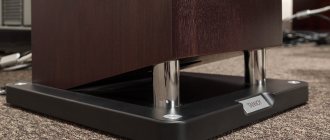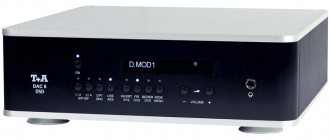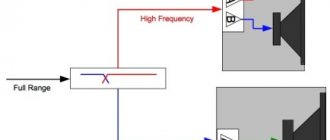Just don’t think that I laid all my cards on the table right in the title and stated the absolute ideality of the speakers being tested. In fact, this is an allusion to the classic Western by John Sturges, which, by the way, was nominated for an Oscar at one time for its musical design.
Well, Tannoy has updated its highly popular Mercury workhorse family. The last, sixth generation lasted on the market for more than ten years, which in itself already says a lot. Well, if so, the more interesting it will be to explore the introduced innovations.
Tannoy Mercury MX-3 – modification
Floor-standing 2-way Tannoy Mercuri MX -3 , these are actually MX-2 shelf units to which a ballast compartment with a plug was added below.
The body is made of 19 mm thick MDF - the front panel, 16 mm chipboard - the back and, most likely, the sides. Between the tweeter and midbass there is an impressive baffle with large holes, which connects with the pads on the side and front walls. Hard and massive.
The volume of the speaker itself ends almost immediately below the bass reflex port, and below that is the box. The walls and partitions inside are covered with artificial felt mats 15-20 mm thick. One of the mats covered the rear end of the bass reflex. I had to secure it so it wouldn't interfere. It is quite possible that for this reason there was practically no difference between an open port and a closed plug.
The original LF coil with an iron core has an inductance of 0.99 mH, the HF coil with a ferrite core has an inductance of 0.3 mH, with a tap in the middle. Plus all kinds of capacitors and resistances. There was not the slightest desire to understand this pile of details.
The sound in the factory version can be briefly described by the word “azzast”. There are no tops. The middle hums and puts a lot of pressure on the ear, to the point of causing discomfort. The bottom is either there or not. Not to the bottom anymore. Verdict - DO NOT listen.
Since there was again room for acoustics, the two useless boxes became very annoying. It was decided to quickly upgrade.
The filter circuit proposed by AB for M-2 is taken as a basis. The elements installed are those that were in stock. The midwoofer inductor is 1.44 mH, and that’s it. High-pass filter: 0.63 mH coil, 3.3 µF capacitor, 2.2 Ohm resistor. Coils from various speakers from the USSR on “air”, made of fierce copper and with the same size and weight. The filter had to be assembled on a separate base and placed between felt mats at the bottom of the main volume. Capacitor K73-11, resistor from Tannoy.
The intermediate result is that the ears no longer suffer, you can listen. But the tonal balance is lacking. The middle is kind of cloudy, not transparent. The upper frequencies are still pressed, although the hi-hat sounds, for example, as it should and as I have heard live more than once. At the same time, the balance floats depending on the signal level, shifting upward as the volume increases. Accordingly, from composition to composition. The soloists still stick out territorially, both men and women. But the difference between the VZ and the bass reflex is clearly audible. The first option is quick and dry. Secondly, it is more impressive and sweeping. Because This acoustics does not pretend to have deep bass, but most likely it is a matter of taste.
Conclusion. The second column will need to be refined by listening carefully, and not sculpted from what is at hand.
Author: oleg leonidovich










